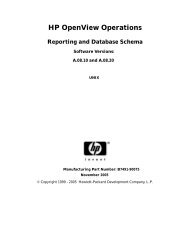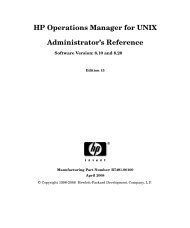Firewall Concepts and Configuration - HP Operations Manager
Firewall Concepts and Configuration - HP Operations Manager
Firewall Concepts and Configuration - HP Operations Manager
You also want an ePaper? Increase the reach of your titles
YUMPU automatically turns print PDFs into web optimized ePapers that Google loves.
HTTPS/TCP Communication<br />
<strong>Firewall</strong> <strong>Configuration</strong> in OVO<br />
OVO Communication <strong>Concepts</strong><br />
HTTPS 1.1 based communications is the latest communication<br />
technology used by <strong>HP</strong> OpenView products <strong>and</strong> allows applications to<br />
exchange data between heterogeneous systems.<br />
OpenView products using HTTPS communication can easily<br />
communicate with each other, as well as with other industry-st<strong>and</strong>ard<br />
products. It is also now easier to create new products that can<br />
communicate with existing products on your network <strong>and</strong> easily<br />
integrate with your firewalls <strong>and</strong> HTTP-proxies.<br />
HTTPS communication provides the following major advantages:<br />
<strong>Firewall</strong> Friendly<br />
Secure<br />
Open<br />
Scalable<br />
DCE/UDP Communication<br />
Since UDP does not do any transmission control, communication packets<br />
can be lost on the network. DCE RPC’s, based on UDP, implement their<br />
own transmission control on a higher level of the communication stack.<br />
Therefore no communication can be lost.<br />
Since UDP is not connection based, everything is cleaned up immediately<br />
after the communication is complete. This makes it the preferred choice<br />
for all nodes where the following applies:<br />
❏ The node is located inside the firewall. See “DCE/UDP<br />
Communication Type” on page 82 for more information.<br />
❏ The node is connected on a good LAN connection where few packets<br />
are lost.<br />
DCE/TCP Communication<br />
TCP is a connection-oriented protocol. The protocol will detect if packets<br />
are dropped on the network <strong>and</strong> re-send only those packets. This makes<br />
it the choice for all bad networks.<br />
Since TCP is connection oriented, it keeps open a connection for a period<br />
after communication is finished. This is to avoid having to reopen a new<br />
connection if other communication is requested later. This can cause<br />
Chapter 1 33







